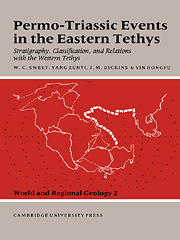 Permo-Triassic Events in the Eastern Tethys
Permo-Triassic Events in the Eastern Tethys Book contents
- Frontmatter
- Contents
- List of contributors
- Preface
- Acknowledgments
- 1 Permo-Triassic events in the eastern Tethys – an overview
- 2 Permo-Triassic boundary relations in South China
- 3 Permo-Triassic boundary of the Indian subcontinent and its intercontinental correlation
- 4 Permo-Triassic boundary on the Indian peninsula
- 5 The Permo-Triassic boundary in the southern and eastern USSR and its international correlation
- 6 Classification and correlation of nonmarine Permo-Triassic boundary in China
- 7 Permian and Triassic events in the continental domains of Mediterranean Europe
- 8 The Permo-Triassic boundary in the Southern Alps (Italy) and in adjacent Periadratic regions
- 9 Permo-Triassic brachiopod successions and events in South China
- 10 Conodont sequences in the Upper Permian and Lower Triassic of South China and the nature of conodont faunal changes at the systemic boundary
- 11 A conodont-based high-resolution biostratigraphy for the Permo-Triassic boundary interval
- 12 The palynofloral succession and palynological events in the Permo-Triassic boundary interval in Israel
- 13 The effects of volcanism on the Permo-Triassic mass extinction in South China
- 14 Geochemical constraints on the Permo-Triassic boundary event in South China
- 15 Permo-Triassic orogenic, paleoclimatic, and eustatic events and their implications for biotic alteration
- 16 Permo-Triassic boundary in Australia and New Zealand
- Index
11 - A conodont-based high-resolution biostratigraphy for the Permo-Triassic boundary interval
Published online by Cambridge University Press: 12 October 2009
- Frontmatter
- Contents
- List of contributors
- Preface
- Acknowledgments
- 1 Permo-Triassic events in the eastern Tethys – an overview
- 2 Permo-Triassic boundary relations in South China
- 3 Permo-Triassic boundary of the Indian subcontinent and its intercontinental correlation
- 4 Permo-Triassic boundary on the Indian peninsula
- 5 The Permo-Triassic boundary in the southern and eastern USSR and its international correlation
- 6 Classification and correlation of nonmarine Permo-Triassic boundary in China
- 7 Permian and Triassic events in the continental domains of Mediterranean Europe
- 8 The Permo-Triassic boundary in the Southern Alps (Italy) and in adjacent Periadratic regions
- 9 Permo-Triassic brachiopod successions and events in South China
- 10 Conodont sequences in the Upper Permian and Lower Triassic of South China and the nature of conodont faunal changes at the systemic boundary
- 11 A conodont-based high-resolution biostratigraphy for the Permo-Triassic boundary interval
- 12 The palynofloral succession and palynological events in the Permo-Triassic boundary interval in Israel
- 13 The effects of volcanism on the Permo-Triassic mass extinction in South China
- 14 Geochemical constraints on the Permo-Triassic boundary event in South China
- 15 Permo-Triassic orogenic, paleoclimatic, and eustatic events and their implications for biotic alteration
- 16 Permo-Triassic boundary in Australia and New Zealand
- Index
Summary
Introduction
In 1979 I made a preliminary attempt to correlate three important sections of Permian and Triassic rock graphically (Sweet, 1979). In the sections considered in that study, data on the ranges of conodonts in strata thought to be Lower Triassic were adequate to suggest that further work might result in a high-resolution biostratigraphic scheme of worldwide significance. Consequently, considerable time was invested in assembling data on the ranges of conodonts in widely distributed sections of Lower Triassic strata and, in 1988 (Sweet, 1988b) a high-resolution biostratigraphic framework was established for the Lower Triassic. That scheme resulted from graphic correlation of sections in Kashmir, Pakistan, Japan, western United States, northern Italy, and far-eastern USSR. Correlation based on the measured ranges in those sections of 29 conodont species resulted in a framework that is divisible at the 95% confidence level into 21 chronozones (or Standard Time Units), each equivalent to a unit 5 m thick in the standard reference section at Guryul Ravine, Kashmir, and each representing approximately the same interval of time.
In 1979 data on the scaled ranges of stratigraphically significant invertebrate fossils were sparse for Permian rocks in the three sections I considered. Consequently, I used crude information on the ranges of scaphopods, bellerophontids, productacean brachiopods, and a few species of cephalopods and conodonts. Since 1979, however, there has been a flood of information on the measured ranges of conodonts and other invertebrates in rocks of the Permo-Triassic boundary interval, which it is now possible to use to expand the high-resolution framework begun in my 1988 report.
- Type
- Chapter
- Information
- Permo-Triassic Events in the Eastern TethysStratigraphy Classification and Relations with the Western Tethys, pp. 120 - 133Publisher: Cambridge University PressPrint publication year: 1992
- 12
- Cited by
